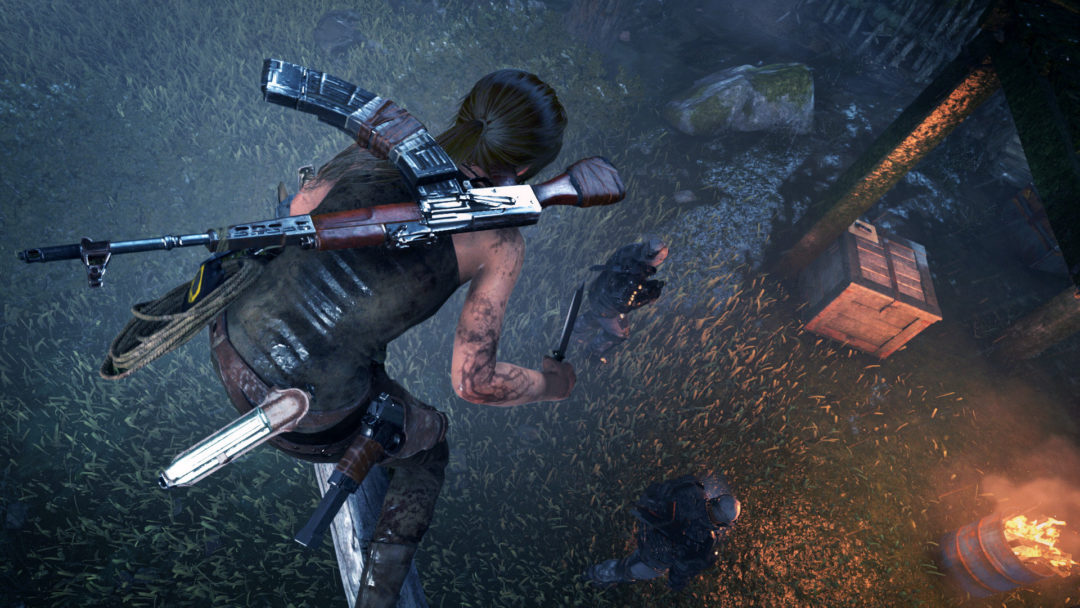Rise of the Tomb Raider is constantly at odds with itself. It draws on the survival genre and themes of religious exploration yet also bombastic action and contrived set pieces. It’s a game that can infuriate and amaze with its unreconciled ambitions and flaws, drawing you back in even after you know it will disappoint you.
After a brief prologue in Syria, the first real level you explore is a pure winter wilderness in Siberia. Lara’s alone, without resources, on the verge of hypothermia. Where the preceding game relied on crafting for ammunition and upgrades, Rise leans more towards Don’t Starve at the scale of a AAA video game. You can see Lara’s ever shiver as she struggles through snowdrifts. The crunch of every salvaged piece of firewood is as satisfying as it is worrying that it might alert something lurking beyond the haze of snowfall. The area is an explorable hub just large enough to leave you scrambling for anything useful. It’s a palpable tension that chills you to the bone.
The ice melts off of Lara’s jacket as she warms, the fear of death stayed for the moment, before she braves out into the frozen wilderness again to gather more supplies. You have to hunt wild animals for food, requiring you to craft a bow and arrows, then pursue your prey as quietly as you can through the frozen forest. It’s quiet and introspective, a more mature Lara left with her thoughts as she seeks out any shred of evidence her father wasn’t crazy.
What a shame then that Rise of the Tomb Raider largely abandons this gameplay approach afterward. When the paramilitary religious order known as Trinity arrives, killing the natives of this land and hunting for you in kind, familiar The Last of Us-style stealth takedowns and arrow headshots take over the gameplay. As a consolation, Crystal Dynamics later gave Rise a DLC “Endurance” mode explicitly about surviving a large wilderness as long as you can, which is great but does nothing to help the game’s story campaign.
The concept of subverting a previously safe space into a hostile battleground can be compelling, but Rise never needed armed mercenaries to convey tension. Minutes later, a perfectly reasonable threat arises: a ferocious bear you have to kill to finally escape the area. It’s a natural barrier that rewards your knowledge of not only combat but scavenging and exploration. An experienced Lara will have ensured she has enough for the coming encounter, while a novice might not have enough supplies or the wits to make it through. Victory feels momentous, a massive hurdle overcome. This is the last fight that feels so rewarding and one of the few remaining animal encounters in the entire game. But don’t you worry — there are plenty of AK-47s and explosions on the horizon.
It’d be so easy for Rise to rely on survival gameplay over bombast. As more recent titles like Death Stranding and Generation Zero have shown us, you don’t need wall-to-wall action to make your game memorable. Tension arises from uncertainty, not color button prompts to watch Lara stab a thousand mercenaries’ necks to pieces or grenade launchers you can refill with a single button press.
The gunplay and stealth are perfectly adequate, but neither enhances Lara’s going on a journey of religious and self-discovery. Demolishing abandoned Soviet outposts doesn’t bring her closer to her late father or process her more recent mourning over the events of the preceding Tomb Raider. If anything, it distracts from what could have been a startling tale.
Lara’s journey in search of the lost city of Kitzeh leads her to meeting the Christ-like “Prophet.” He’s immensely charismatic and immediately interesting, and his backstory raises plenty of philosophical questions about life after death. Then the Trinity invading the Prophet’s village necessitates he transform into kung-fu Jesus and join in on the stabbing.
The majority of the most meaningful questions are brushed aside until the game’s final moments for the sake of drama. Finally in a cave with the Prophet? Better talk about Trinity, no time to question him about the nature of existence. Finally at the Prophet’s village? Look at that — Trinity’s bombing the place and setting all the houses on fire! Worse still, Lara ends up coming across as a White Savior the villagers and Prophet need to rely on, rather than the other way around. Lara doesn’t learn anything from them. In fact, her only personal revelations are tied to the antagonists leading the Trinity invasion force.

Rise comes across as terrified of what players might think of Tomb Raider going in a different direction, as the entire prologue in Syria first acts as a homage to classic parkour and puzzle solving, then leans hard into the action, only to then finally reach the wonders of Siberia. It’s not even like the parkour and puzzle elements don’t work in this setting. The game’s Metroidvania world is marvelous, rewarding clever exploration with not only collectibles but valuable supply caches.
The second Siberia hub area is full of things to find, and you first arrive to find it infested with wolves. It’s another natural progression of the game world, but once again Trinity goons soon replace the wolves and you start assembling an armory of guns. Then later sections become more about pure combat and collectibles, increasingly losing sight of where Rise began. It’s like two games in one, and one of them is highly uninspired.
Imagine if that weren’t the case. What if the journey had been simply to reach the Prophet and learn his teachings, navigating around a hostile Siberian wilderness and learning about why the Prophet’s people had isolated themselves along the way? Given the metaphysical shenanigans, creatures of Siberian folklore could’ve been lurking in those old Soviet bunkers, not Trinity’s finest pincushions. There’s enough lootable resources around the various hubs to warrant return runs to recover from more intense encounters. Such encounters could’ve been more sparingly used too, harnessed as a punctuation mark like the bear fight. And along those lines, using campfires to keep yourself from freezing could’ve been a central mechanic keeping players from going too far without proper preparation.
This is supposed to be a modern Lara Croft, one free from the conventions of the past. So why not show that by having her leave a place intact, respecting those that came before and humbled with the knowledge she carries? She’d be at peace knowing her father was right. She’d also be less terrified of the mystical world, realizing that her harrowing journey on the island of Yamatai was just one side of a more complicated story than anyone could have imagined.
Rise of the Tomb Raider had the perfect premise to further reinvent Lara Croft. Its predecessor’s tagline for Game Informer was literally “A Survivor Is Born,” so there was all the more reason to double down on an interpretation people loved. It’s not that the game as it is fares poorly; it’s perfectly fine as an action-adventure title. Yet the game settled for adequate when it could’ve been extraordinary.
